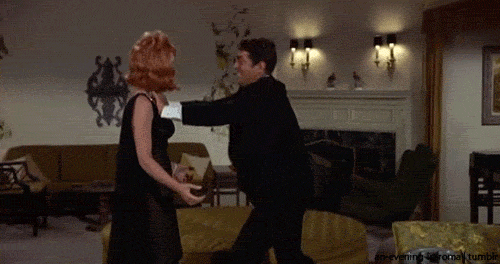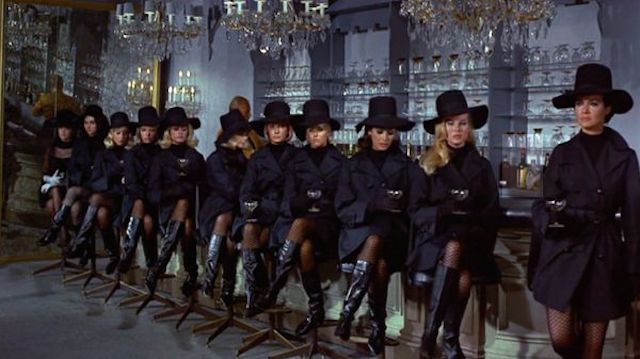
Studio Spymasters
The realization that MGM had struck the mother lode in the James Bond pictures set off a studio scramble to find comparable franchises. They optioned rival books, renamed and repackaged foreign rip-offs, adapted beach films and monster flicks to include spy angles—everything they could possibly do, except make a good movie themselves.

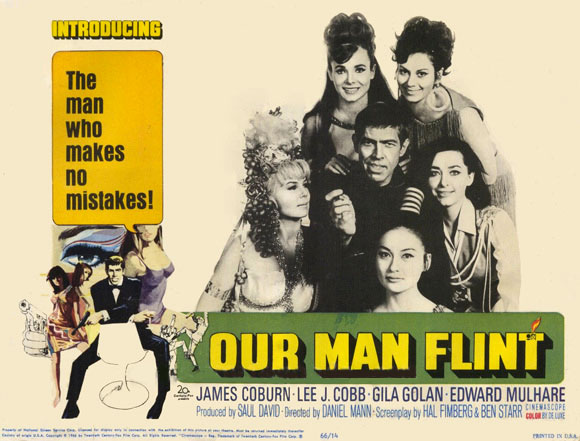
DEREK FLINT OF Z.O.W.I.E.
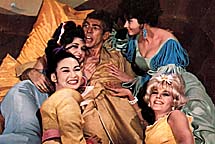 James Coburn and non-pleasure units in James Coburn and non-pleasure units in
In Like Flint
Twentieth-Century Fox was the first studio to challenge the Bond films when they initiated the archly ironic Flint series, which gave tough guy James Coburn his first starring role as Derek Flint of Z.O.W.I.E. (Zonal Organization for World Intelligence and Espionage—which zone they are in, I have no idea.) Derek Flint is a man of seemingly inexhaustible skills who knows everything there is to know about everything. He jets off to Moscow in his private Lear to instruct ballet at the Bolshoi. He performs emergency surgery with no implement fancier than a key sterilized over a candle flame. Like a Zen master, he can slow his cardiopulmonary functions to near-death stillness for three hours at a stretch. He writes mathematical progression ciphers in his head. He kills flies with blowdarts. He can identify the origin of a sample of bouillabaisse by the proportion of ingredients used to prepare it. Flint's got a cigarette lighter that has eighty-two different functions "...eighty-three if you wish to light a cigar." The one thing Flint can't do? Find a coherent story to star in.
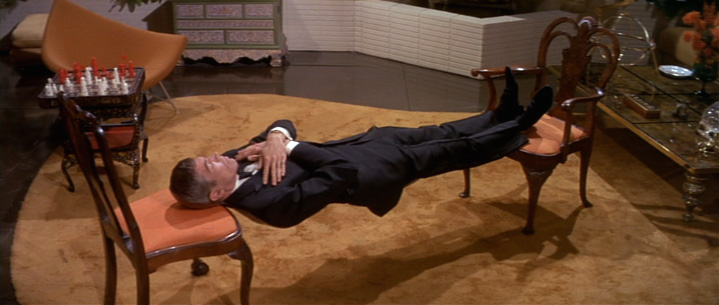
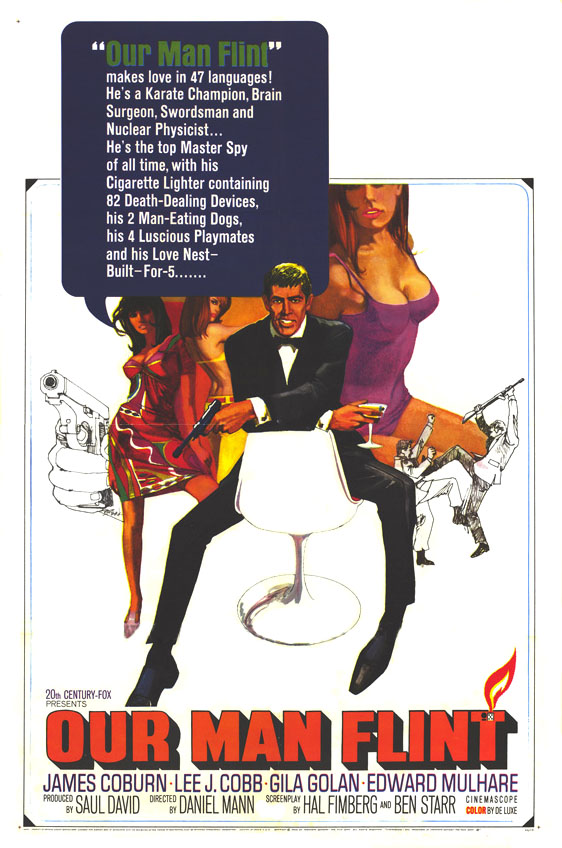 In OUR MAN FLINT (1966), he saves the world from the nefarious Exotica Cosmetics company, which is actually GALAXY, a criminal organization that intends to bring the planet to its knees by manipulating the weather. This doesn't bother Flint until they kidnap the four concubines living in his penthouse. Then GOD HELP THOSE BASTARDS! In OUR MAN FLINT (1966), he saves the world from the nefarious Exotica Cosmetics company, which is actually GALAXY, a criminal organization that intends to bring the planet to its knees by manipulating the weather. This doesn't bother Flint until they kidnap the four concubines living in his penthouse. Then GOD HELP THOSE BASTARDS!
Flint tracks the villains to France based on an analysis of the poison on the tip of a dart, a dart that's been handled by a person who has just eaten a particular bouillabaisse made only in the city of Marseilles. Flint samples every bouillabaisse in the city and after visiting every high class restaurant in the city, discovers it in (where else) a sleazy strip joint, where he gets the help of "0008"—a tough but slightly inferior British superspy, modeled after... guess who—who gladly defers to the superior American agent. From there on it's a typical Bond adventure: getting trapped, seducing the bad girl, saving the world, blah, blah, blah...
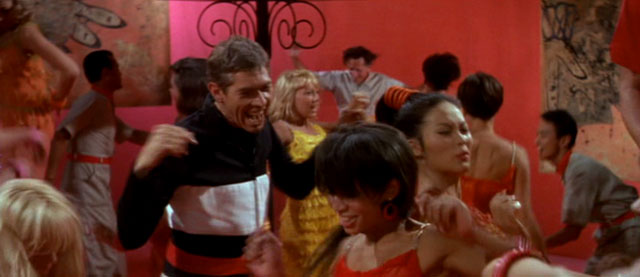
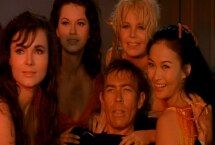 The movie really shows its age in its depiction of women. Females at the Galaxy base are mentally programmed to be "pleasure units" for the men. Flint breaks in, rescues and deprograms them... and how do they thank him? By jumping all over him in a veritable gang-bang, taking turns with the main love interest in making out with Flint, of course. You don't get more sixties with a "happy ending" than that! The movie really shows its age in its depiction of women. Females at the Galaxy base are mentally programmed to be "pleasure units" for the men. Flint breaks in, rescues and deprograms them... and how do they thank him? By jumping all over him in a veritable gang-bang, taking turns with the main love interest in making out with Flint, of course. You don't get more sixties with a "happy ending" than that!
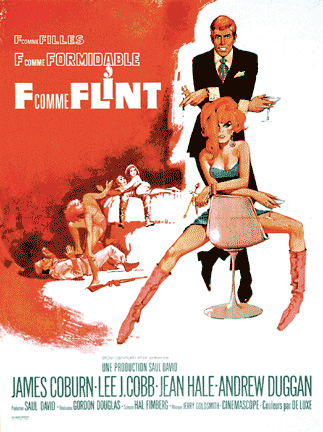 Still, the film was probably the best of the Bond imitators, and was released the same year as THUNDERBALL. But it's really more like the Bond films of the 70's—an action-comedy rather than an action-adventure film with a few comedic elements. Still, the film was probably the best of the Bond imitators, and was released the same year as THUNDERBALL. But it's really more like the Bond films of the 70's—an action-comedy rather than an action-adventure film with a few comedic elements.
The film contains direct nods to James Bond in a comedic and outlandish style. Flint is initially offered a Walther PPK and an attache case with a concealed throwing knife with Flint dismissing both as "crude." During the French strip club sequence, Flint stages a mock brawl with a patron who is identified as Agent 0008, a British secret agent. Flint asks if SPECTRE (the criminal organization in the early Bond movies) is involved, to which Agent 0008 replies, "It's bigger than SPECTRE!" The actor playing the role is similar in appearance to Sean Connery. Later in the film, the character of Gila (played by Gila Golan) is shown reading a 0008 novel, a reference to the James Bond novels.
The distinctive ringtone of Cramden's "presidential hotline" telephone was re-used in the films "Hudson Hawk" (1991), "Austin Powers: International Man of Mystery" (1997), and in Seattle children's television program, "The J.P. Patches Show." Popular LA KIIS-FM disc jockey Rick Dees used the sound effect as the "hotline" phone sound whenever the station manager would call and yell at him during his 1980s and 1990s shows. Speaking of recycling, the name "Hans Gruber" (character played by Michael St. Clair) was reused 22 years later in the film "Die Hard" (1988) for Alan Rickman's character.
The Flint films can't compete with the best of the Bonds, as they substitute camp and spoof for drama and sweep. As parodies, they cannot exist without Bond, or ever hope to outdo those films. They never really become true spy stories.
They were expected to earn less, so they were made for less. Therefore, we don't get to visit any real-life "exotic" locations—Flint's encounters in Marseilles and Rome all take place on the Fox back lot.

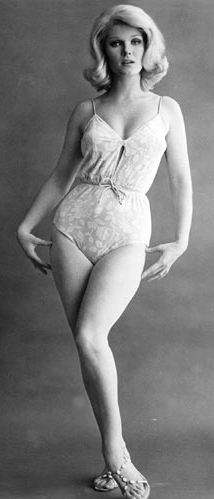 IN LIKE FLINT (1967) features female supervillains who exploit... women. The tagline for the film went: "FLINT'S BACK In Action... In Danger... In the Virgin Islands... Where the Bad Guys... Are Girls!" IN LIKE FLINT (1967) features female supervillains who exploit... women. The tagline for the film went: "FLINT'S BACK In Action... In Danger... In the Virgin Islands... Where the Bad Guys... Are Girls!"
ZOWIE head Lloyd Cramden is knocked out with paralyzing gas during a golf game with the President. A surgically altered actor is then substituted for The President. Cramden engages agent Derek Flint to find out what happened. Traveling to Moscow and the Virgin Islands, Flint discovers a consortium of fashion queens are planning to take over the world. They have already brainwashed most of the women in the world onto their side using microchips planted inside hairdryers. Now they have smuggled two female Russian cosmonauts aboard a US Space Platform and are planning to fire nuclear weapons from it unless men surrender to them.
Again, Flint doesn't do much until the villains make the mistake of brainwashing his concubines. Will these evil villains never learn? They are trapped on the Virgin Islands by Jean Hale (pictured at right—hey that figure was HOT in the sixties!).
Flint takes a break from teaching ballet at the Bolshoi and communicating with dolphins to foil the bad girls. From their beauty-spa base in the Virgin Islands this glamorous cabal has managed to infiltrate Z.O.W.I.E., stick a presidential impostor in the White House (Coburn shakes his head in disbelief, "An actor playing the President"), and devise a way to control women's minds through... hair dryers!
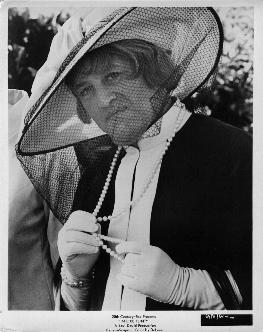 Once again, Flint saves the day, saves Lee J. Cobb from torture and acting career suicide as he is dressed as a woman, infiltrating the island (I can here him on the set now: "Quit laughing! I was in DEATH OF A SALESMAN on Broadway! I got raves!"), de-brainwashes his concubines once more and tells them to think for themselves... but in a twist, Flint doesn't hang around for the traditional "individualist" gangbang—he instead goes into space to commit interstellar sex with hot Russian cosmonauts (your typical tan, thin platinum-blonde Russian peasants from the 1960's), teaching them to be independant—and therefore, they gangbang him, too! Once again, Flint saves the day, saves Lee J. Cobb from torture and acting career suicide as he is dressed as a woman, infiltrating the island (I can here him on the set now: "Quit laughing! I was in DEATH OF A SALESMAN on Broadway! I got raves!"), de-brainwashes his concubines once more and tells them to think for themselves... but in a twist, Flint doesn't hang around for the traditional "individualist" gangbang—he instead goes into space to commit interstellar sex with hot Russian cosmonauts (your typical tan, thin platinum-blonde Russian peasants from the 1960's), teaching them to be independant—and therefore, they gangbang him, too!
The title was a play on the old phrase about actor Errol Flynn, "In like Flynn." But strangely, the phrase overtook its root and now "in like flint" is the more common phrase!
The Austin Powers films have directly spoofed many aspects of the Flint pictures, including costumes, the private jet—Austin even says the Flint films are his favorite movies! The best is the sound of the presidential red phone, which is the exact same as Austin's boss' call.
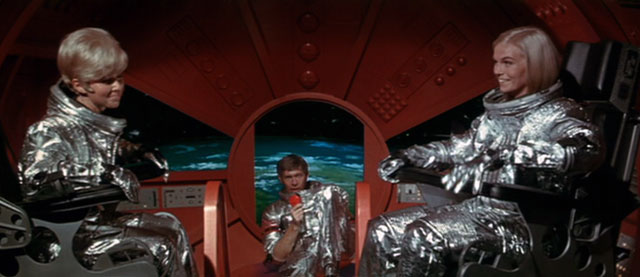
 Although not great, the Flint films were at least watchable, and probably the most popular of the Bond spinoffs with audiences and critics. Hollywood tried to resurrect the franchise several times. First, another sequel with Coburn, THE BRIDE OF FLINT, was announced, but never filmed. Although not great, the Flint films were at least watchable, and probably the most popular of the Bond spinoffs with audiences and critics. Hollywood tried to resurrect the franchise several times. First, another sequel with Coburn, THE BRIDE OF FLINT, was announced, but never filmed.
Also left unrealized was a TV pilot script, titled "FLINT LOCK" by fantasy author Harlan Ellison.
When a small screen version of the character finally surfaced, it was in the form of an execrable 1976 TV movie titled DEAD ON TARGET: OUR MAN FLINT, featuring trascendentally smug Ray Danton as Flint. The Flint character is now more of a private investigator, not nearly as smart, and not nearly as fun. It's now available in a box DVD set with the two other Flint films, but it's totally unwatchable.
The Flint films were sexist, unoriginal, cheaply made and badly crafted... but they were masterpieces compared to the next studio entry:

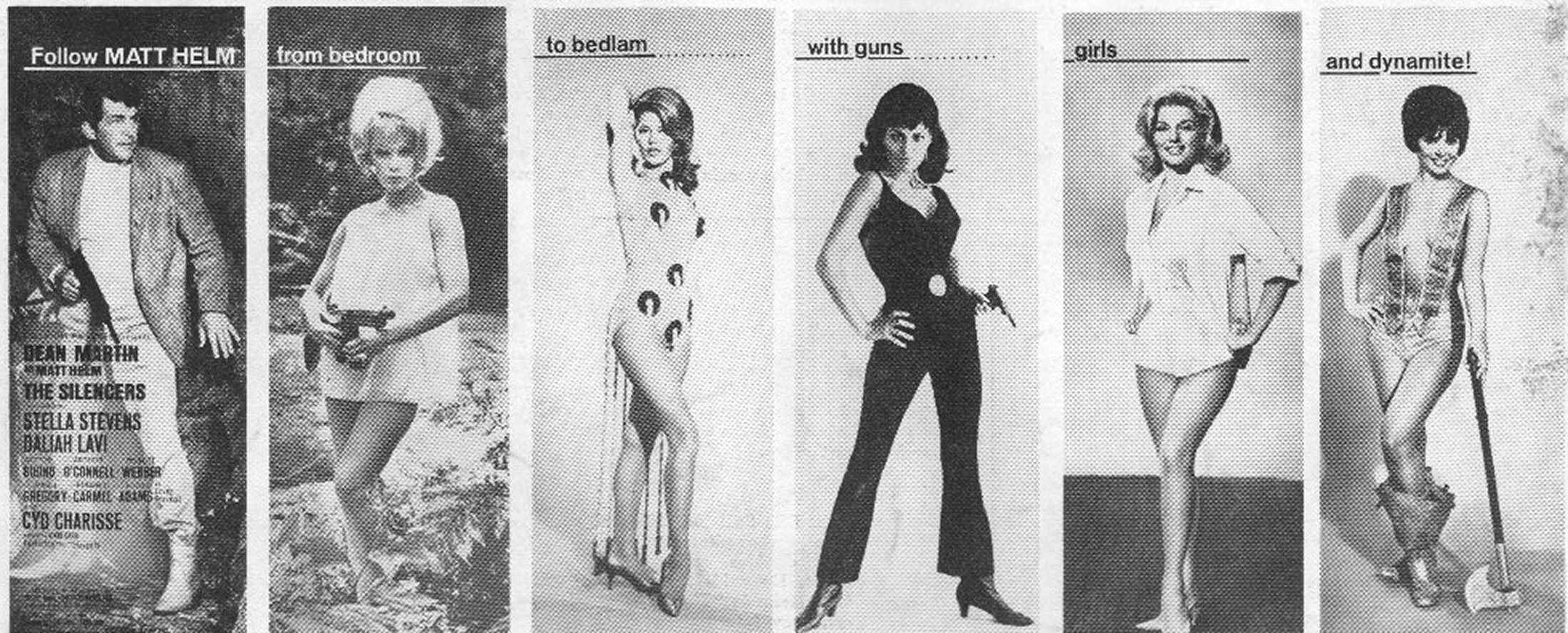
MATT HELM OF I.C.E.
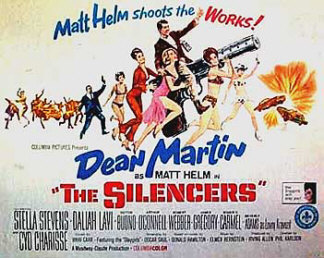 "If you identified with James Bond, you had to know your wines. If you identified with Matt Helm, all you had to do was drink and not fall down." "If you identified with James Bond, you had to know your wines. If you identified with Matt Helm, all you had to do was drink and not fall down."
—Doug Pratt review.
Columbia Pictures aimed low and scored a financial bull's-eye with the Matt Helm series. By the mid-1960s, James Bond was the biggest phenomenon in film, and movie producers were looking for any espionage-oriented property they could find. Producer Irving Allen (1905-1982) had a special reason for looking. He and his former partner, Albert R. Broccoli, had severed their ties because Broccoli wanted desperately to bring Ian Fleming's James Bond novels to the screen... while Allen thought the books were atrocious. Broccoli, of course, went on to partner with Harry Saltzman and make the Bond films. They became multi-millionaires while Allen, with egg on his face, was left to follow their lead, and looked for another spy franchise.
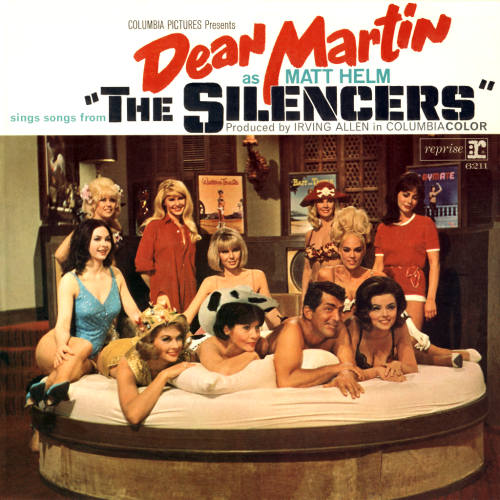 The Matt Helm paperback series, written by Donald Hamilton, were ideal, because they were about a hard-boiled government assassin, like Bond—only he worked for the United States instead of Britain. Critic Anthony Boucher even wrote: "Donald Hamilton has brought to the spy novel the authentic hard realism of Dashiell Hammett; and his stories are as compelling, and probably as close to the sordid truth of espionage, as any now being told." But any thought of a serious spy franchise flew out the window faster than a bullet from a Ninja rocket gun when Allen cast crooner Dean Martin as Helm. Most famous as the straight man for Jerry Lewis, then for his membership in Sinatra's "Rat Pack," Martin had his own variety show on TV, singing the latest hits and doing an impersonation of a lush (how much acting went into the lush impersonation depends on who you talk to). The Matt Helm paperback series, written by Donald Hamilton, were ideal, because they were about a hard-boiled government assassin, like Bond—only he worked for the United States instead of Britain. Critic Anthony Boucher even wrote: "Donald Hamilton has brought to the spy novel the authentic hard realism of Dashiell Hammett; and his stories are as compelling, and probably as close to the sordid truth of espionage, as any now being told." But any thought of a serious spy franchise flew out the window faster than a bullet from a Ninja rocket gun when Allen cast crooner Dean Martin as Helm. Most famous as the straight man for Jerry Lewis, then for his membership in Sinatra's "Rat Pack," Martin had his own variety show on TV, singing the latest hits and doing an impersonation of a lush (how much acting went into the lush impersonation depends on who you talk to).
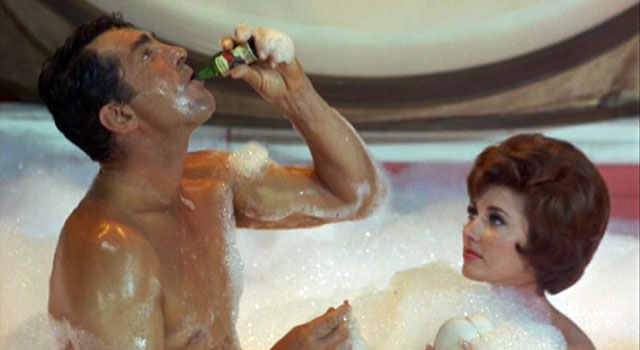
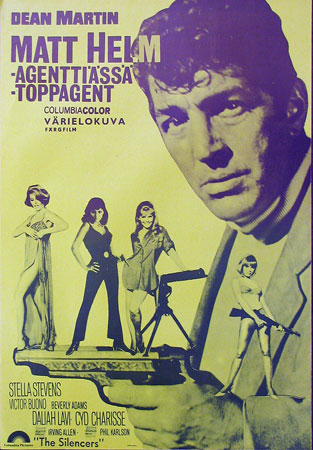 Martin quickly haggled his way into co-producing, and the series went from being anything close to Hamilton's books into instead a theatical version of Dean's TV show—basically a 2-hour Bond spoof sketch. Martin quickly haggled his way into co-producing, and the series went from being anything close to Hamilton's books into instead a theatical version of Dean's TV show—basically a 2-hour Bond spoof sketch.
The four films—THE SILENCERS, MURDERER'S ROW (both 1966), THE AMBUSHERS (1967) and THE WRECKING CREW (1968)—starred Martin as flabby, bibulous secret agent Helm, who works as a cheesecake photographer of scantily-clad women for "Slaymate" magazine as a cover job, but who really spies for the Intelligence Counter Espionage (ICE) organization. Helm saves the world from various colorful villains while bestowing his dubious charms on an array of scantily clad women, including Senta Berger, Janice Rule, Ann-Margret, Stella Stevens, Elke Sommer, Sharon Tate and Tina Louise.
Leering, stupid and overtly sexist, the Matt Helm pictures are jaw-droppers: cultural time capsules that must be seen to be believed.
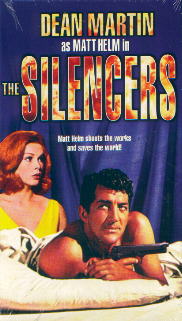 Hamilton's paperback series began with Death of a Citizen (1960) and continued through 27 books, the last being published in 1993. The first of these to be filmed, THE SILENCERS, was adapted the first and fourth of Hamilton's books. (Although it largely jettisoned the plots of both books and borrowed the villain's world domination scheme from DR. NO). Hamilton's paperback series began with Death of a Citizen (1960) and continued through 27 books, the last being published in 1993. The first of these to be filmed, THE SILENCERS, was adapted the first and fourth of Hamilton's books. (Although it largely jettisoned the plots of both books and borrowed the villain's world domination scheme from DR. NO).
The promo copy read: "Dean Martin, in his neat role as super secret agent Matt Helm—sophisticate of the world, gutty guy, virile adventurer, devil with the dollies... in The Silencers, Martin plays no poor man's secret agent. Martin secret agents right: dressed up snappy by Sy Devore... chased by nasty Chinese bandits... surrounded by kiss-n-kill cuties... ambushed in motel rooms with supine Slaygirls... every girl he meets makes Apassionata Von Climax look like one runt kid."
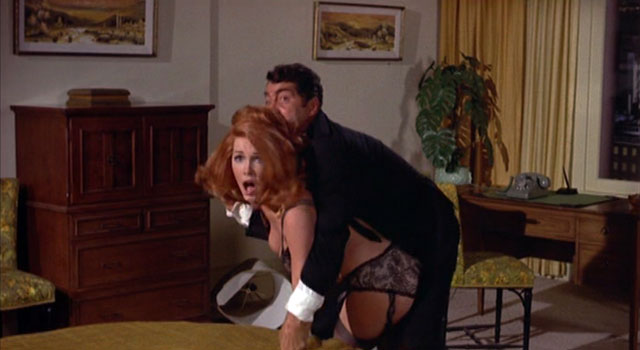
In this film, a SPECTRE-like group of super-villains called BIG-O threaten to redirect a missile to an underground nuclear test site, thus releasing deadly radiation throughout the American southwest. (Why anybody would want to control a land contaminated with radiation, I have no idea.)

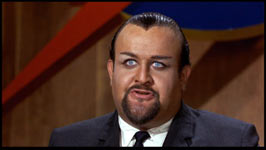 The leader of BIG-O is named Tung-Tze (played by BATMAN villain Victor Buono, sporting what is possibly worst Asian makeup ever—he looks like Anton LeVay). He does hilarious Asian things... like drink from a can of delicious "Low-Cal Egg Foo Yung." (Apparently the script got rewritten. Herbert Baker, who had written some of the Martin & Lewis comedies of the 1950s, has a "parodies by" credit.) The leader of BIG-O is named Tung-Tze (played by BATMAN villain Victor Buono, sporting what is possibly worst Asian makeup ever—he looks like Anton LeVay). He does hilarious Asian things... like drink from a can of delicious "Low-Cal Egg Foo Yung." (Apparently the script got rewritten. Herbert Baker, who had written some of the Martin & Lewis comedies of the 1950s, has a "parodies by" credit.)
The opening dance number, which is sort of cool in a 60's retro/cheezy way, features burlesque strippers, their privates covered by title cards, with Cyd Charisse lip-synching to Vikki Carr: "A gun can be a .22 or [accompanied by a squeeze of her breasts] a .38." I know that's not a great line, but it's the best you'll get in this movie.
 Dino doesn't even drive a cool car. No Aston Martin here—Matt Helm drives a prehistoric-looking 1966 Mercury Colony Park Station Wagon, complete with faux wood paneling, a back seat that becomes a bed (don't all station wagons basically do that?), and best of all, the most politically incorrect gadget in Hollywood history: a pull-out, fully stocked mini-bar, so that Martin and Stevens can drink the hours away on their long drive (don't tell M.A.D.D. about that optional extra). Dino doesn't even drive a cool car. No Aston Martin here—Matt Helm drives a prehistoric-looking 1966 Mercury Colony Park Station Wagon, complete with faux wood paneling, a back seat that becomes a bed (don't all station wagons basically do that?), and best of all, the most politically incorrect gadget in Hollywood history: a pull-out, fully stocked mini-bar, so that Martin and Stevens can drink the hours away on their long drive (don't tell M.A.D.D. about that optional extra).
While the film was greeted enthusiastically by the ticket-buying public, members of the Matt Helm Fan Club picketed the film's opening.
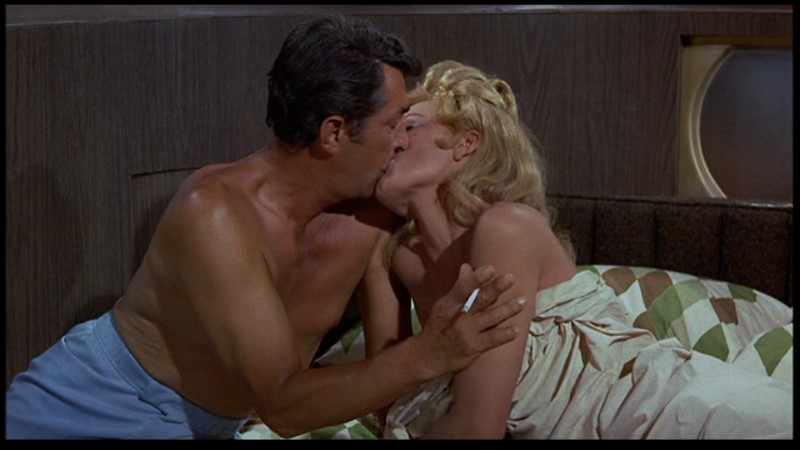
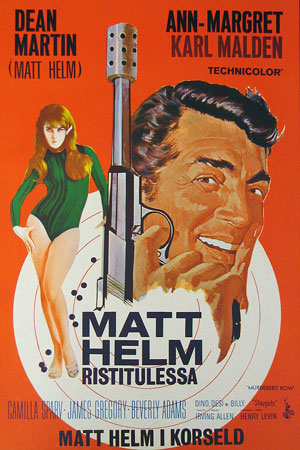 MURDERER'S ROW upgrades Helm's wheels from a station wagon to a four-door Thunderbird, which is a little cooler, at least. It opens with "Big O" attempting to kill Helm by boiling him alive in his own swimming-pool-sized bathtub (Helm's circular bed automatically slides across the bedroom and plops him and whatever model he's sleeping with that afternoon into the bubble bath each morning.) But of course, it's all just a ruse by Helm, who fakes his death so that he can investigate "Big O" unmolested, which is more than Helm's 'Slaymate' models can say. (Not that they're smart enough to mind: Helm says to one of his patriotically-dressed calendar girls during a photo shoot: "You're the Spirit of '76", to which she replies "No I'm only a 44.") MURDERER'S ROW upgrades Helm's wheels from a station wagon to a four-door Thunderbird, which is a little cooler, at least. It opens with "Big O" attempting to kill Helm by boiling him alive in his own swimming-pool-sized bathtub (Helm's circular bed automatically slides across the bedroom and plops him and whatever model he's sleeping with that afternoon into the bubble bath each morning.) But of course, it's all just a ruse by Helm, who fakes his death so that he can investigate "Big O" unmolested, which is more than Helm's 'Slaymate' models can say. (Not that they're smart enough to mind: Helm says to one of his patriotically-dressed calendar girls during a photo shoot: "You're the Spirit of '76", to which she replies "No I'm only a 44.")
The film was based on the fifth Helm novel of the same title, which took place in and around Chesapeake Bay. The producers shifted the action to the more glamorous Monte Carlo, but Dino didn't want to travel abroad. So a second unit filmed in and around Cannes, with a double for Martin (looking about a foot shorter) used in a lot of establishing shots. Dean Martin then did the close-ups back in the US, in front of a lot of rear-projection shots.
In the novel, the fifth of the paperback series, Helm investigates the disappearance of a scientist named Michaelis. For the film, the scientist became Dr. Norman Solaris, inventor of the "Helio Beam." What a "Helio Beam" does is never explained.
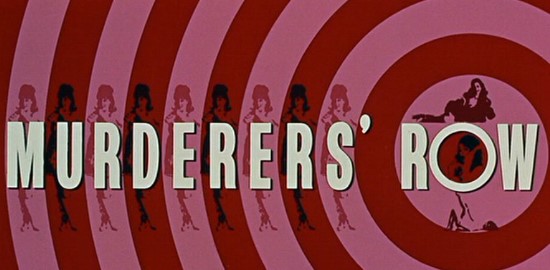
Helm's gadgets in this film include a martini glass froster that freezes bad guys, and a talking bottle of booze that activates when Helm tries to drink (his boss, "Mac," knew he'd go there first). The most important gadget in all of the Helm films, however, is the turtleneck sweater, which hides Dino's turkey neck.
Karl Malden is the comic-bookish super-villain who delivers everything in a faux-European accent that ends up sounding more like a dock worker ("Karl Malden rises to new heights as a rotten human being," according to the film's trailer). His henchman has a metal plate on top of his head, which Helm continually attempts to Karate-chops, hurting his hand. Good plan, Matt...

Ann-Margret, in one of her earliest roles, at least dances with a great deal of energy (at one point the camera zooms into her breasts and goes split-screen so we can watch four breasts jiggling). At one point, Martin rips off her miniskirt, which contains an explosive, and hurls it at a wall decorated with Frank Sinatra's picture. Dino, Desi, & Billy, a popular rock and roll group of the day which featured Martin's real-life son, Dean Paul Martin, makes a guest appearance.
Released on December 20, 1968, the film was the eleventh highest-grossing film of the year—although it grossed about a million dollars less than The Silencers, and made only a tenth of what the latest James Bond movie grossed. But it actually finished in second place at the 1967 Producer's Guild of America's Laurel Awards for Best Action Drama (!!!) and Best Action Performance for Martin (!!!!). Coburn's IN LIKE FLINT was also nominated for both awards in those categories. (They were both promoted as comedies, but I guess since nobody in the audiences were laughing, they were nominated as action-dramas.)
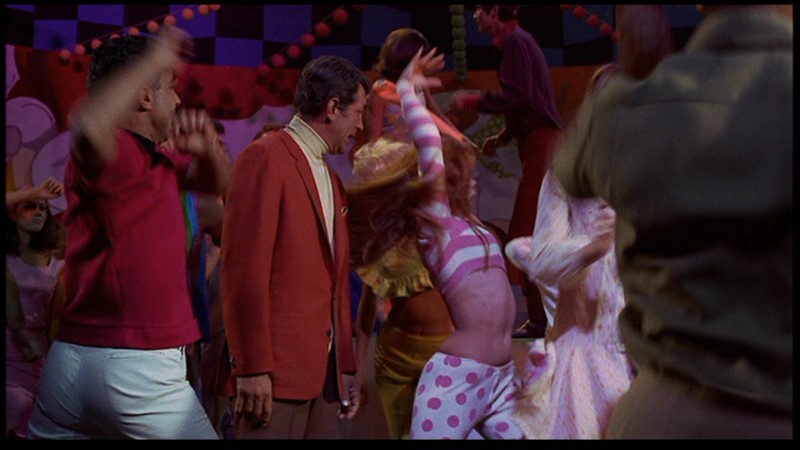
In THE AMBUSHERS (listed as one of The Fifty Worst Films Of All Time in 1977, in a book by Michael Medved), Helm is assigned to find a stolen flying saucer, and he has to take fellow agent Sheila Sommers (Janice Rule) with him, because only females can fly the saucer. The reason is because the saucer uses "electromagnetic fields" to propel itself, and, according to the movie, electromagnetic fields are lethal to males. (Not coincidentally, I fear that electromagnetic waves from the TV while watching this film killed many of my brain cells.) Judith Crist wrote in her review: "The sole distinction of this vomitous mess is that it just about reaches the nadir of witlessness, smirky sexiness and bad taste—and it's dull, dull, dull to boot."
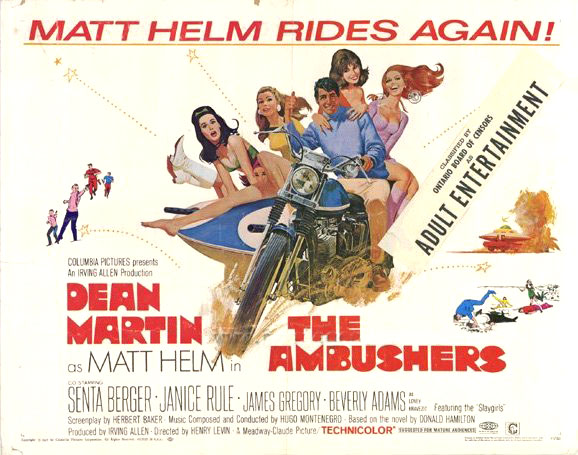
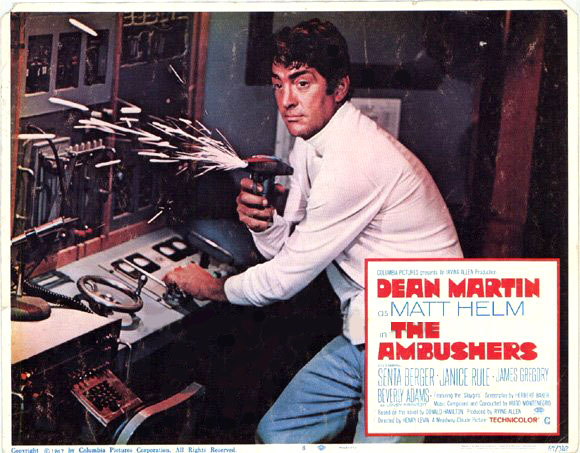 The women have all the best gadgets in this film—they kill bad guys with guns disguised as brassieres (later used in the Austin Powers series). There is a fight sequence inside a giant vat of beer, and Matt dispatches one of his enemies by pushing him into a beer intake valve, then takes a drink. (Since they were filming at Desilu studios—where the TV series Star Trek was being filmed—some of the props from that show actually ended up in the film!) The women have all the best gadgets in this film—they kill bad guys with guns disguised as brassieres (later used in the Austin Powers series). There is a fight sequence inside a giant vat of beer, and Matt dispatches one of his enemies by pushing him into a beer intake valve, then takes a drink. (Since they were filming at Desilu studios—where the TV series Star Trek was being filmed—some of the props from that show actually ended up in the film!)
The jokes are the weakest yet: When his female companion tries to come on to him at one point, he says "In broad daylight?", and she says "What's wrong with a broad in daylight?" In another scene, someone raises a glass to Helm, who just happens to have one of his own. "Skol!" is the toast. "Sure," drawls Dino, "it's got ice in it."
The final scene shows Helm trying to teach an attractive new recruit how to make love while on the job. The recruit is cold and unresponsive, even after Helm puts on a Dean Martin tune. But when he puts on Perry Como, she responds amorously, much to his chagrin. The best/worst gadget is Helm's belt, which turns into a sword by getting it wet. If he ever soils himself in a drunken stupor he'll stab himself! Amazingly, this was the highest-grossing film of the series, taking in $10 million! (Not as much as a Bond film—but pretty good for a film swiping props left on the set from TV shows!)

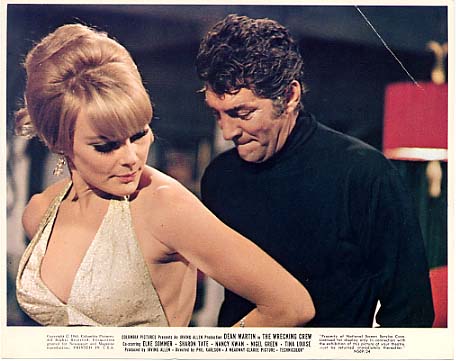 THE WRECKING CREW, the last film of the series, features a 52 year-old Martin as Helm, as he matches wits with Elke Sommer, and, in one fight scene, battles future bland action hero Chuck Norris (okay, his stuntman fights Norris—he is 52, after all). THE WRECKING CREW, the last film of the series, features a 52 year-old Martin as Helm, as he matches wits with Elke Sommer, and, in one fight scene, battles future bland action hero Chuck Norris (okay, his stuntman fights Norris—he is 52, after all).
As a possible tribute to the film's Chinese action choreographer, future Kung Fu superstar Bruce Lee, a chorus at the start of the film sings: "Ah So, Ah So, Velly Velly Nice."
The story opens with the evil Count Massimo pilfering a few billion dollars of gold bullion from a train. The gold bullion belongs to the USA. It was on a train heading through Denmark on its way to London. (Why is US gold on a train from Denmark to London? I have no idea) He has an evil 12-step plot to cripple the economies of Britain and the US, and announces over the course of the film when they enter into each step, and how many seconds they're behind schedule (which he pronounes "shejool," to sound European, I guess). If that doesn't give away how Americanized he is, his lair was actually the real-life home of actor Tony Curtis!
 We them see Helm, in need of a 12-step program himself, falling asleep at a photoshoot and blissfully dreaming. We then see a "romantic" montage with Helm smooching the very models he couldn't stay awake to photograph. But then, Martin abandons his pin up girls and shuffles over to... wait for it... a nearby cow. He then slides onto a milking stool and proceeds to knead her udders (to which every 12-year-old in the audience probably yelled, "wrong teats, Matt!"). As this is going on, we hear Dino crooning to the tune of "Sunny Side of the Street": We them see Helm, in need of a 12-step program himself, falling asleep at a photoshoot and blissfully dreaming. We then see a "romantic" montage with Helm smooching the very models he couldn't stay awake to photograph. But then, Martin abandons his pin up girls and shuffles over to... wait for it... a nearby cow. He then slides onto a milking stool and proceeds to knead her udders (to which every 12-year-old in the audience probably yelled, "wrong teats, Matt!"). As this is going on, we hear Dino crooning to the tune of "Sunny Side of the Street":
grab your coat and get your pail
lemme take you in the barn, dear—
just sit back and watch
cause I found a cow who gives scotch.
Helm is then called in to find the gold, and travels to Denmark, meeting up with Lola Medina (a post-"Gilligan's Island" Tina Louise—nice career move, Tina), and with the accident prone Freya Carlson (future Manson Family casualty Sharon Tate), ostensibly a klutzy functionary for the Denmark Department of Tourism, but really a... wait for it... klutzy SPY!
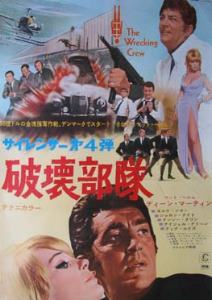 Girls, gadgets, gin and gags: Girls, gadgets, gin and gags:
the Matt Helm formula distilled
The filmmakers have not only run out of teat jokes, they also seem to have run out of gadget ideas, which include nothing more than a black sock that is hurled at the bad guys, a film camera that emits green fog (!), a briefcase that contains the parts to assemble a helicopter in two minutes (Stevie Ray Vaughn would be proud), and a gun that fires on a ten second delay (perfect to shoot those guys you anticipate will show up in exactly ten seconds). Macdonald, Helm's chief, is played by John Larch in this film, replacing James Gregory, who played the role in the other three films. This is also the only film in the series not to feature Helm's secretary, Lovesy Kravesit.
The last line in the credits promises: "COMING UP NEXT: THE RAVAGERS," but the film earned only $2.4 million during its theatrical run, likely ending the series. Legend has it that a grief-stricken Dean Martin held up the next film's production after the murder of Sharon Tate, who was expected to return to the Helm series, and the project fell apart.
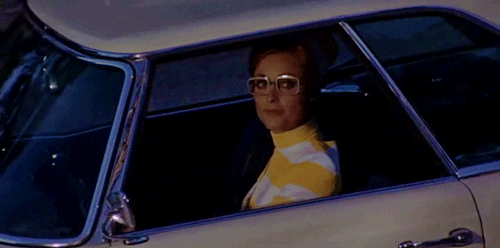
A "Tony Rome Meets Matt Helm" movie with Frank Sinatra reprising the character he had played in the films TONY ROME (1967) and LADY IN CEMENT was discussed but never shot, like a ten second delay gun that never did fire. As with Flint, Hollywood tried to resurrect the character as a TV private investigator in the 1970's with Tony Franciosa in the main role. It made the Martin films look like THE THIRD MAN by comparison, and lasted only a few episodes.
BOND RIPS OFF RIP-OFFS: These films did seem to have a huge effect on the Bond producers, whose films after OHMSS took on the jokier tone of the Helm films. Ideas from these tasteless extravaganzas kept showing up in later 007 films:
Gold bullets with the hero's name from THE SILENCERS ended up as a plot device in THE MAN WITH THE GOLDEN GUN
Helm fakes his own death in MURDERERS' ROW and Bond did the same a year later in YOU ONLY LIVE TWICE
A dart-shooting cigarette, first seen in MURDERERS' ROW, also ends up in YOU ONLY LIVE TWICE (but steal even more)
Hovercrafts from MURDERERS' ROW showed up in DIAMONDS ARE FORVER
The hovercraft chase through downtown streets became a gondola ten years later in MOONRAKER
Matt Helm strips Sheila (played by Janice Rule) of her clothes by way of a magnetic gadget in THE AMBUSHERS, which is repeated by Roger Moore's 007 in LIVE AND LET DIE.
A metal-headed villain is foiled with a large overhead magnet in MURDERERS' ROW, and then THE SPY WHO LOVED ME.
We're not sure if these rip-offs are an intentional tribute to Broccoli's former partner, or an f-you, or just plain theft, but they're pretty obvious. Other Bond rip-offs had less to offer:

THE LIQUIDATOR (1965)
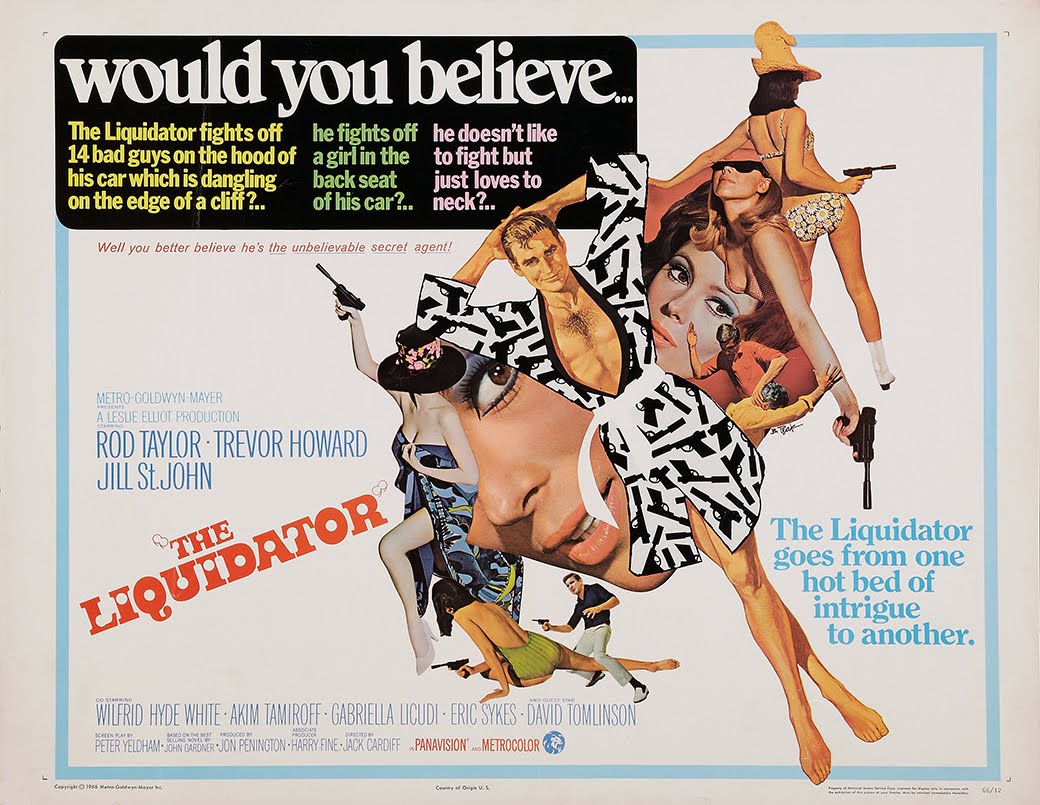
 Rod Taylor plays Brian "Boysie" Oakes in this James Bond parody. (In fact, it's based on a novel by John Gardner, who later continued the Bond series of books.) Brian "Boysie" Oakes was a character created by John Gardner as a sort of antithesis of James Bond. Sure he is a secret agent, well more of an assassin really, and he is surrounded by gorgeous girls. But underneath it all, he is a coward with no stomach for killing, and an intense fear of flying. Strangely enough, nearly all Oakes adventures feature flying, after all, a globe trotting agent isnִ much good if he can trot. And adding insult to injury, in Gardner's final Oakes novel, The Airline Pirates, Boysie is forced to set up his own airline called Air Apparent. But here, a quote from Madrigal (Corgi 1968), the fourth book in the series: "The words came out in a strangle of panic. Boysie had a natural aversion to taking airplane rides. It was a state bordering on the pathological. He was sick in aircraft and usually in a state of shock from takeoff to touch down.' Then screen then explodes into colour and a loud brash animated title sequence, by Richard Williams takes over. The Liquidator had actually been made in 1964 but a squabble over legal rights held up the release for two years. It was filmed on location in Nice, Monte Carlo and the Antibes among other exotic places frequented by jet-setting super-spies. An album of Lalo Schifrin's score was released in 1965 (sample tunes: "Boysie's Bossa" and "Bikini Waltz") with a theme song by Shirley Bassey, who sang more official Bond themes than anybody else. Rod Taylor plays Brian "Boysie" Oakes in this James Bond parody. (In fact, it's based on a novel by John Gardner, who later continued the Bond series of books.) Brian "Boysie" Oakes was a character created by John Gardner as a sort of antithesis of James Bond. Sure he is a secret agent, well more of an assassin really, and he is surrounded by gorgeous girls. But underneath it all, he is a coward with no stomach for killing, and an intense fear of flying. Strangely enough, nearly all Oakes adventures feature flying, after all, a globe trotting agent isnִ much good if he can trot. And adding insult to injury, in Gardner's final Oakes novel, The Airline Pirates, Boysie is forced to set up his own airline called Air Apparent. But here, a quote from Madrigal (Corgi 1968), the fourth book in the series: "The words came out in a strangle of panic. Boysie had a natural aversion to taking airplane rides. It was a state bordering on the pathological. He was sick in aircraft and usually in a state of shock from takeoff to touch down.' Then screen then explodes into colour and a loud brash animated title sequence, by Richard Williams takes over. The Liquidator had actually been made in 1964 but a squabble over legal rights held up the release for two years. It was filmed on location in Nice, Monte Carlo and the Antibes among other exotic places frequented by jet-setting super-spies. An album of Lalo Schifrin's score was released in 1965 (sample tunes: "Boysie's Bossa" and "Bikini Waltz") with a theme song by Shirley Bassey, who sang more official Bond themes than anybody else.
Richard Harris was initially approached for the role but after negotiations chose to do The Heroes of Telemark instead. Taylor insisted on playing the role with an American accent because he was more comfortable with it by that stage in his career.[4] Rod Taylor was an Australian actor who became popular in Hollywood in the late 1950s in films like The Time Machine (1960), The Birds (1963) and Zabriskie Point (1970). Director Jack Cardiff was a former cinematographer who won an Oscar for Black Narcissus (1947), received Academy Award nominations for three more films and accepted an honorary award in 2001. He's also had a sporadic directing career which includes a true oddity—Scent of Mystery (1960), the only film ever made in "Smell-O-Vision," Young Cassidy (1965) starring Rod Taylor as writer Sean O'Casey (the film was initially started by John Ford, who was unable to complete it due to health reasons), and the cult favorite Girl on a Motorcycle (1968) starring Marianne Faithful. Director Jack Cardiff has said that censors mandated deletion of Rod Taylor's line that said, "... it smells like a Turkish wrestler's jockstrap."
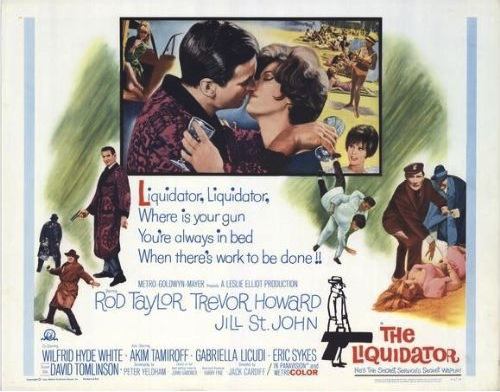 During V-E Day celebrations in Paris, Boysie inadvertently saves the life of Intelligence Major Mostyn (Trevor Howard). It opens in black and white. The end of the Second World War is near, and Boysie is commanding a tank. But he is lost. As he stumbles around the streets of Paris in search of directions, he comes across a British Intelligence Officer, Colonel Mostyn (Trevor Howard), being accosted by two assassins. Oakes is no hero, but wades in to help anyway. As he does so, he trips over and Oakes accidentally fires his pistol. The shot kills one of the assailants. Then the kick from the first shot, sends Oakes over onto his backside. He accidentally fires again. The second bullet finds its target and the other assailant falls to the ground dead. As Mostyn struggled for his life, he wasn't watching Oakes. All Mostyn can see is the aftermath. Oakes has cleanly killed two men, with two shots. Mostyn is impressed and locks away in his mind Oakes's details. Intelligence may have use for a man such as this. Years later, when Mostyn needs a hatchet man, he signs Oakes into the Secret Service, thinking the young man is a killing machine, and pays him a visit. Boysie is now running a cafe, that is, when he is not cutting a sexual swathe through all the "birds" in the vicinity. It's this womanizing that gets Boysie into trouble, and gives Mostyn the leverage to blackmail Boysie into working for him. During V-E Day celebrations in Paris, Boysie inadvertently saves the life of Intelligence Major Mostyn (Trevor Howard). It opens in black and white. The end of the Second World War is near, and Boysie is commanding a tank. But he is lost. As he stumbles around the streets of Paris in search of directions, he comes across a British Intelligence Officer, Colonel Mostyn (Trevor Howard), being accosted by two assassins. Oakes is no hero, but wades in to help anyway. As he does so, he trips over and Oakes accidentally fires his pistol. The shot kills one of the assailants. Then the kick from the first shot, sends Oakes over onto his backside. He accidentally fires again. The second bullet finds its target and the other assailant falls to the ground dead. As Mostyn struggled for his life, he wasn't watching Oakes. All Mostyn can see is the aftermath. Oakes has cleanly killed two men, with two shots. Mostyn is impressed and locks away in his mind Oakes's details. Intelligence may have use for a man such as this. Years later, when Mostyn needs a hatchet man, he signs Oakes into the Secret Service, thinking the young man is a killing machine, and pays him a visit. Boysie is now running a cafe, that is, when he is not cutting a sexual swathe through all the "birds" in the vicinity. It's this womanizing that gets Boysie into trouble, and gives Mostyn the leverage to blackmail Boysie into working for him.
At first, it doesn't seem too bad. Boysie is relocated to a swinging pad in London, and soon has a new coterie of girls to seduce. Even the military training that he is put through doesn't seem too difficult. It's only when Boysie is sent out into the real world, and actually has to kill someone, that things get difficult. So difficult in fact, he chooses not to do it. Instead, he hires a hitman, Griffen (Eric Sykes) to do his dirty work for him.
Boysie's assignment is to liquidate security risks among British intelligence—a job that requires a ruthless assassin who can stare calmly into the face of death.
But Boysie is a mild-mannered fun-seeker who is terrified of airplanes and couldn't hurt a fly. He winds up hiring a professional killer to do the dirty work while he zeroes in on his desired target—Miss MacIntosh (Jill St. John, later of Diamonds Are Forever), Mostyn's personal assistant. They jet down to the Riviera for a secret romp, but when they arrive in Nice, foreign and friendly agents plunge Boysie into intrigue.
Forced by circumstances to perform unaccustomed feats of valor—including foiling a hijacking—Boysie, to his own surprise, justifies the expectations of his benefactor.
Variety summed up The Liquidator thusly: "The vulnerable Oakes is played with plenty of charm and guts by Taylor, though he hardly suggests a character with such fundamental failings and frailties as Boysie."
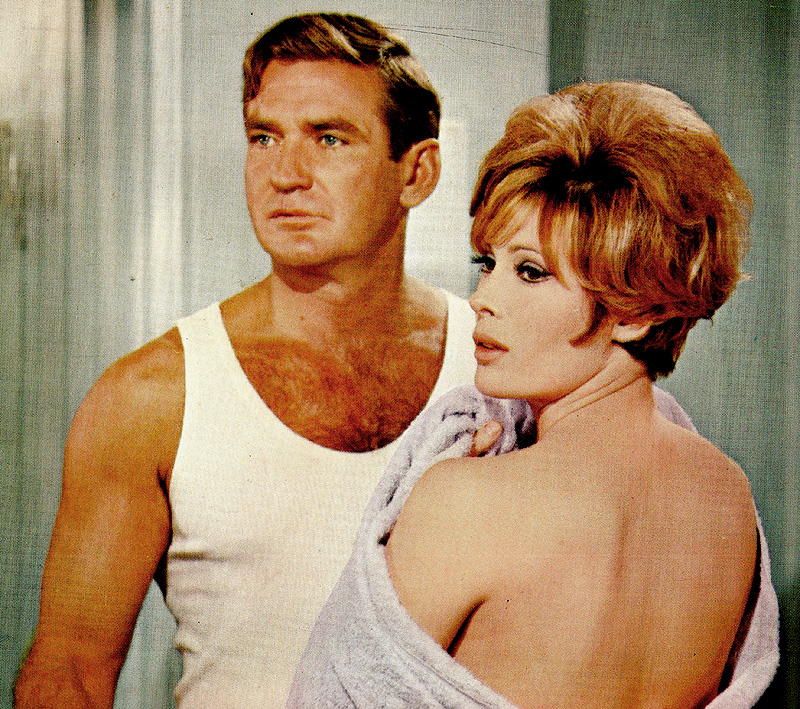

FATHOM OF H.A.D.E.S.
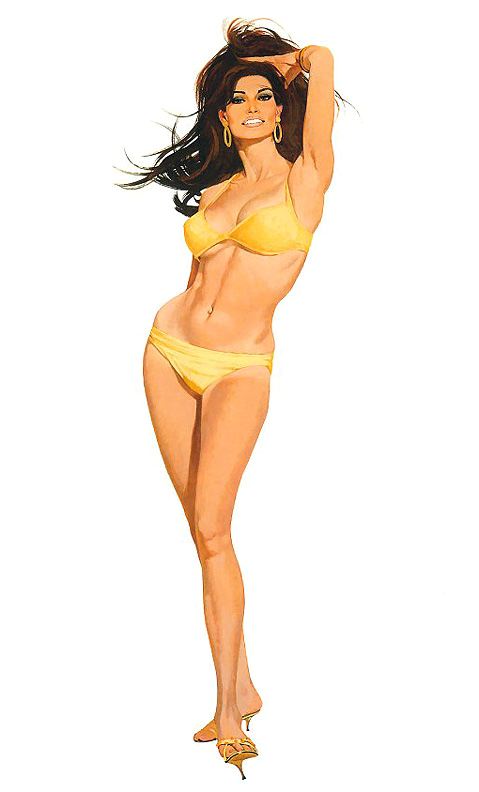 After the Flint series ended, Twentieth Century Fox had the bright idea of making Bond and the "Bond girl" the same character, casting sex goddess Raquel Welch to star in FATHOM (1967)—or more to the point, her lime green bikini would star. (The bikini even gets its own credit: from Vog of Paris.) After the Flint series ended, Twentieth Century Fox had the bright idea of making Bond and the "Bond girl" the same character, casting sex goddess Raquel Welch to star in FATHOM (1967)—or more to the point, her lime green bikini would star. (The bikini even gets its own credit: from Vog of Paris.)
Fathom Harvill (Raquel Welch), dental hygienist by day, is in Spain to take part in a skydiving contest when a pair of British government agents (they work for "HADES") recruit her for a highly sensitive mission: to parachute into the house of a suspected defector-slash-millionaire Peter Merriwether (Tony Franciosa) in order to help them recover a missing H-bomb detonator codenamed "Fire Dragon." But in actual fact Merriwether is hoping to obtain the Fire Dragon from a Russian defector called Serapkin (Clive Revill). And as Fathom is to find out, the good guys and the bad guys aren’t easy to tell apart.
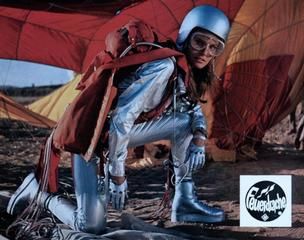 Director Leslie H. Martinson leaves the camera focused mainly on Welch's body parts, to the point where most of the continuity mistakes are with her underwear. For instance, Fathom falls down at least twice while being chased by a bull. The first time she falls, her underwear is black. The second time her underwear is white. Never before has blooper-hunting seemed so rewarding. Director Leslie H. Martinson leaves the camera focused mainly on Welch's body parts, to the point where most of the continuity mistakes are with her underwear. For instance, Fathom falls down at least twice while being chased by a bull. The first time she falls, her underwear is black. The second time her underwear is white. Never before has blooper-hunting seemed so rewarding.
This film has a lot of mondo-spy connections—star Anthony Franciosa would star in a TV version of MATT HELM, while screenwriter Lorenzo Semple Jr. would go on to write the renegade Bond film NEVER SAY NEVER AGAIN.
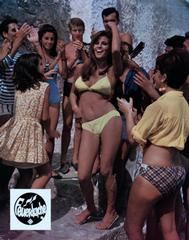 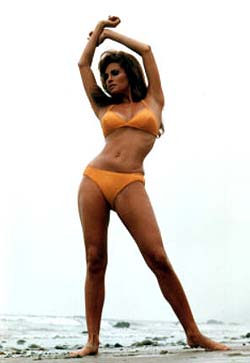 Raquel herself had auditioned for both THUNDERBALL and OUR MAN FLINT. While losing out on parts in those films, she became a superstar in films like ONE MILLION YEARS, B.C., and FANTASTIC VOYAGE, thus earning her own spy franchise. But unlike Raquel, this film had no legs. There would never be a sequel for this particular spy/parachutist/dental hygienist character, but Welch's bikini would still get plenty of work for the rest of the decade. Raquel herself had auditioned for both THUNDERBALL and OUR MAN FLINT. While losing out on parts in those films, she became a superstar in films like ONE MILLION YEARS, B.C., and FANTASTIC VOYAGE, thus earning her own spy franchise. But unlike Raquel, this film had no legs. There would never be a sequel for this particular spy/parachutist/dental hygienist character, but Welch's bikini would still get plenty of work for the rest of the decade.
Beyond characters like Flint, Helm and Fathom, studios attempted to cash in on Bond fever as quickly as they could, acquiring cheaper, independently made productions, and releasing them as if they were classy spy thrillers:

AGENT FOR H.A.R.M.
 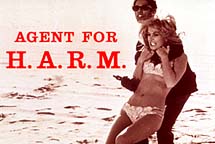 Harmless, charmless and dead Harmless, charmless and dead
in the water
Universal didn't bother with a series, but produced several secret agent spoofs that were transparent attempts to cash in on Bondmania in 1966. In AGENT FOR H.A.R.M. (aka THE H.A.R.M. MACHINE), fuzzy sweater-clad secret agent Adam Chance (Mark Richman, who would go on to a long career playing creepy fathers in bad horror films) protects a scientist from evil Russian agents who try to infiltrate the scientist's secret lair—which is in this case a beach house with a bikini-clad niece in the suburbs. The scientist has created a really gooey biological weapon... A bomb? No. A super-contagious virus? No. It's a spore gun—if you shoot it at your enemy, it splatters him with some green goo that slowly kills him... allowing him plenty of time to just get a regular gun and shoot your ass. But the Russians want the spore so they can—wait for it—use it to covertly crop-dust every farm in the US with the spore and poison our vegetables. Simple, right?

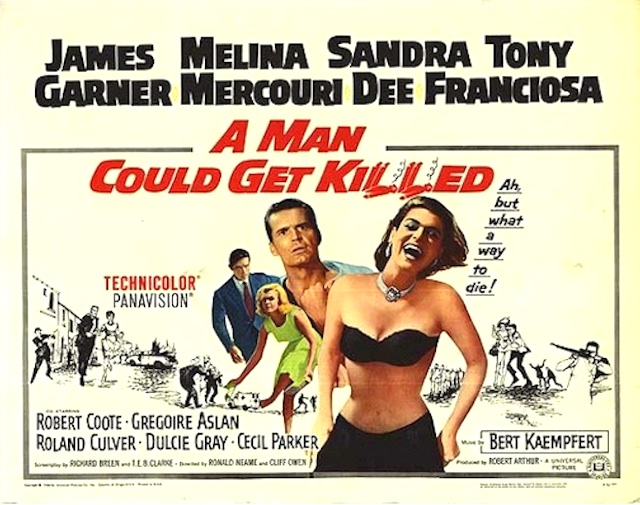
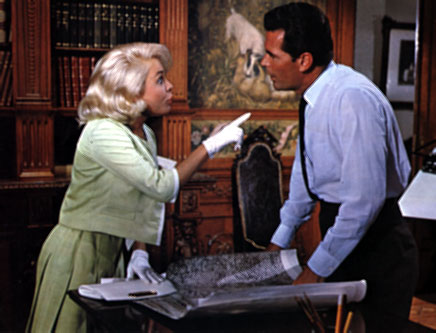 A MAN COULD GET KILLED, also released in 1966, was an adventure comedy shot on location around the Mediterranean and starring James Garner, Melina Mercouri, Sandra Dee, Anthony Franciosa, and Robert Coote. The film was written by David E. Walker (from his novel Diamonds For Danger), Richard L. Breen, and T.E.B. Clarke, and directed by Ronald Neame and Cliff Owen. Garner plays William Beddoes, a businessman who is traveling in Lisbon. He's mistaken for an English spy who's thought to possess a cache of industrial diamonds. Soon he is pursued by Aurora-Celeste da Costa (Mercouri), Steve-Antonio (Franciosa), and a host of other colorful troublemakers, all chasing him for something he doesn't have. From the New York Times review: "When Jack Valenti, the former White House aide, was appointed president of the Motion Picture Association of America, he allowed that he had never seen a bad movie come out of Hollywood. Now is his chance to begin his education." The cast had a falling out with director Cliff Owen who was replaced by Ronald Neame in July 1965. Neame also recalled that co-stars James Garner and Tony Franciosa did not get on well and their fight in the film became a real brawl. This movie introduced the song "Strangers In The Night" which Sandra's husband at the time, Bobby Darin, reportedly recorded. But Frank Sinatra released it first, and the rest is history..."Doo bee doo bee do..." A MAN COULD GET KILLED, also released in 1966, was an adventure comedy shot on location around the Mediterranean and starring James Garner, Melina Mercouri, Sandra Dee, Anthony Franciosa, and Robert Coote. The film was written by David E. Walker (from his novel Diamonds For Danger), Richard L. Breen, and T.E.B. Clarke, and directed by Ronald Neame and Cliff Owen. Garner plays William Beddoes, a businessman who is traveling in Lisbon. He's mistaken for an English spy who's thought to possess a cache of industrial diamonds. Soon he is pursued by Aurora-Celeste da Costa (Mercouri), Steve-Antonio (Franciosa), and a host of other colorful troublemakers, all chasing him for something he doesn't have. From the New York Times review: "When Jack Valenti, the former White House aide, was appointed president of the Motion Picture Association of America, he allowed that he had never seen a bad movie come out of Hollywood. Now is his chance to begin his education." The cast had a falling out with director Cliff Owen who was replaced by Ronald Neame in July 1965. Neame also recalled that co-stars James Garner and Tony Franciosa did not get on well and their fight in the film became a real brawl. This movie introduced the song "Strangers In The Night" which Sandra's husband at the time, Bobby Darin, reportedly recorded. But Frank Sinatra released it first, and the rest is history..."Doo bee doo bee do..."

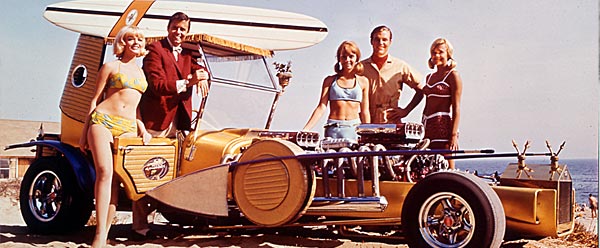
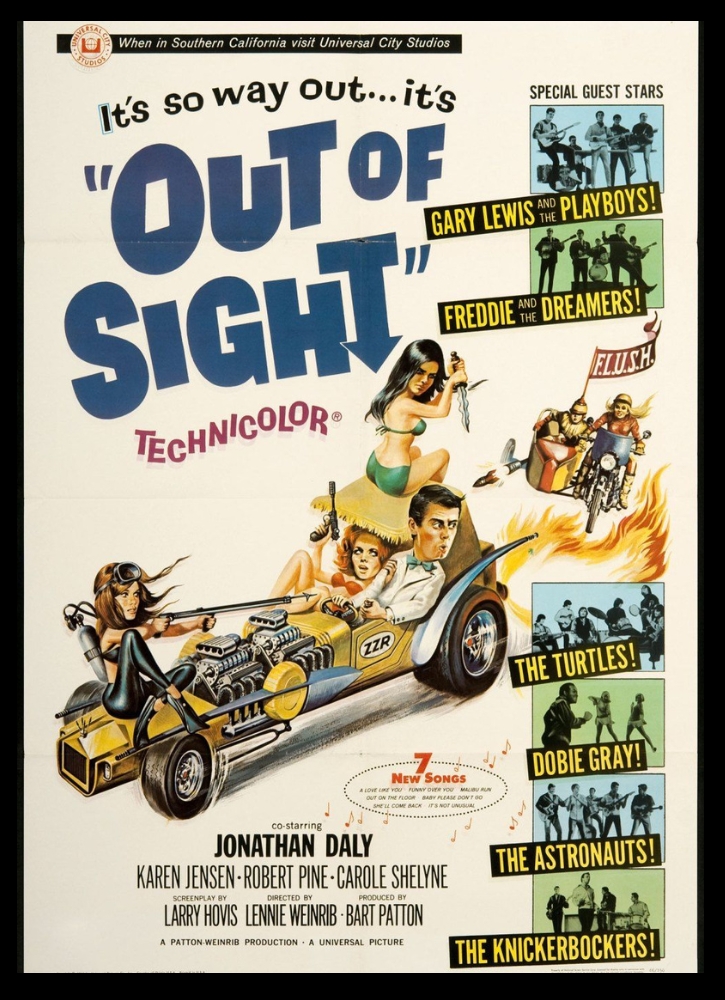 For beach music fans, there was the bizarre genre hybrid OUT OF SIGHT (tag line: "It's so way out ... it's 'Out of Sight'"), an uneasy blend of musical comedy, teen pic and spy thriller, directed by the immortal Lennie Weinrib and producer Bart Patton for Universal Pictures. Universal and MCA signed a contract in 1965 for the pair to make 14 rock 'n' roll films in a two-year period; however, the only ones produced were WILD WILD WINTER and this film. The title of the film was originally announced as THUNDER BLUNDER, a parody of THUNDERBALL. In this film, Jonathan Daly (who would go on to appear in a million bad Disney TV movies) plays "Homer," a butler to superspy John Stamp. He steps in for his absent boss to face a Russian-type villain called Big D (John Lawrence) aiming to sabotage the local teen scene, and yet another mad scientist at the beach. (These mad scientists get all the cool beach houses!) Big D tries to bump off Homer using a group of assassin babes, including Wende Wagner (from the "Green Hornet" TV series) and the amazing Deanna Lund (from "Land of the Giants"), who plays a hip swinging bad girl called "Tuff Bod"! It also featuring some gags about a girl and a male midget on a motor cycle as agents of—wait for it—"F.L.U.S.H.", and lots of hunks and bikini girls doing the "jerk" at the beach to Gary Lewis and the Playboys, the Astronauts, the Turtles, concert footage of Freddie and the Dreamers and Dobie Gray. Those damn Russians always spoil all the fun! For beach music fans, there was the bizarre genre hybrid OUT OF SIGHT (tag line: "It's so way out ... it's 'Out of Sight'"), an uneasy blend of musical comedy, teen pic and spy thriller, directed by the immortal Lennie Weinrib and producer Bart Patton for Universal Pictures. Universal and MCA signed a contract in 1965 for the pair to make 14 rock 'n' roll films in a two-year period; however, the only ones produced were WILD WILD WINTER and this film. The title of the film was originally announced as THUNDER BLUNDER, a parody of THUNDERBALL. In this film, Jonathan Daly (who would go on to appear in a million bad Disney TV movies) plays "Homer," a butler to superspy John Stamp. He steps in for his absent boss to face a Russian-type villain called Big D (John Lawrence) aiming to sabotage the local teen scene, and yet another mad scientist at the beach. (These mad scientists get all the cool beach houses!) Big D tries to bump off Homer using a group of assassin babes, including Wende Wagner (from the "Green Hornet" TV series) and the amazing Deanna Lund (from "Land of the Giants"), who plays a hip swinging bad girl called "Tuff Bod"! It also featuring some gags about a girl and a male midget on a motor cycle as agents of—wait for it—"F.L.U.S.H.", and lots of hunks and bikini girls doing the "jerk" at the beach to Gary Lewis and the Playboys, the Astronauts, the Turtles, concert footage of Freddie and the Dreamers and Dobie Gray. Those damn Russians always spoil all the fun!

MORE US SPYTACULARS:
A Man Called Dagger (1967). Low budget American spy film. Future Bond villain Richard Kiel (Jaws) co-stars.
Come Spy with Me (1967), American spy film starring Troy Donahue.
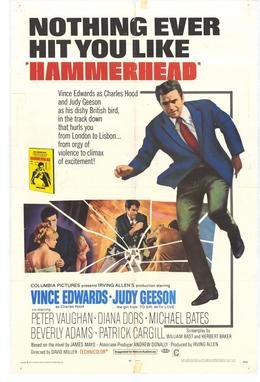 With Hammerhead (1968), Columbia Pictures tried to cash in on Bondmania again with this film, directed by David Miller and starring Vince Edwards, Judy Geeson, and Diana Dors; It was based on the 1964 novel of the same name by James Mayo; produced by Irving Allen and written by Herbert Baker (the team behind the first three Matt Helm films). The "Charles Hood" novels have an extra pedigree in spy literature because author James Mayo (the pen name of Stephen Coulter) was friendly with Ian Fleming. Both men had served in Royal Navy Intelligence during World War II, became reporters, Reuters correspondents and both eventually wrote for the Sunday Times. Coulter helped Fleming with background details in the first novel, Casino Royale. In this film, British intelligence asks a soldier of fortune, Charles Hood, to go to Portugal and help stop an international criminal mastermind and pornographic art collector called "Hammerhead." (Or as his secretary calls him, "Mr. Hammerhead.") There were five Charles Hood novels, but only one film. With Hammerhead (1968), Columbia Pictures tried to cash in on Bondmania again with this film, directed by David Miller and starring Vince Edwards, Judy Geeson, and Diana Dors; It was based on the 1964 novel of the same name by James Mayo; produced by Irving Allen and written by Herbert Baker (the team behind the first three Matt Helm films). The "Charles Hood" novels have an extra pedigree in spy literature because author James Mayo (the pen name of Stephen Coulter) was friendly with Ian Fleming. Both men had served in Royal Navy Intelligence during World War II, became reporters, Reuters correspondents and both eventually wrote for the Sunday Times. Coulter helped Fleming with background details in the first novel, Casino Royale. In this film, British intelligence asks a soldier of fortune, Charles Hood, to go to Portugal and help stop an international criminal mastermind and pornographic art collector called "Hammerhead." (Or as his secretary calls him, "Mr. Hammerhead.") There were five Charles Hood novels, but only one film.
European Enigmas || Italian Jobs || Kovert Komedy || Hong Kong Humint || 00-XXX || Boob Tube
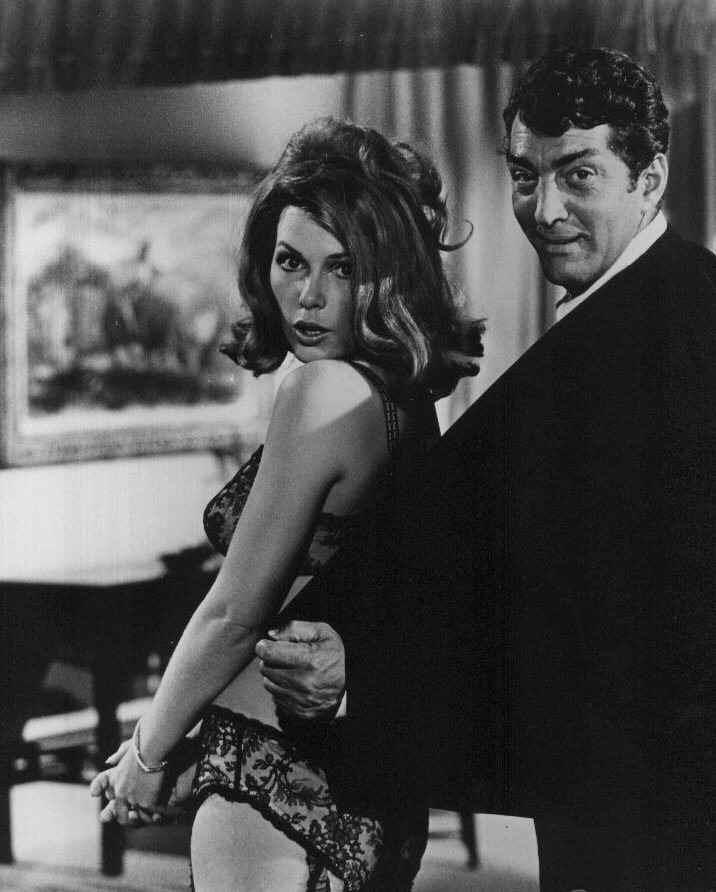
Photo credits (top to bottom): Everett Collection, Archive Photos, Everett Collection (2)
Music: "I'm Not The Marrying Kind (Matt Helm's Theme)", written by Howard Greenfield, performed by Dean Martin
|
